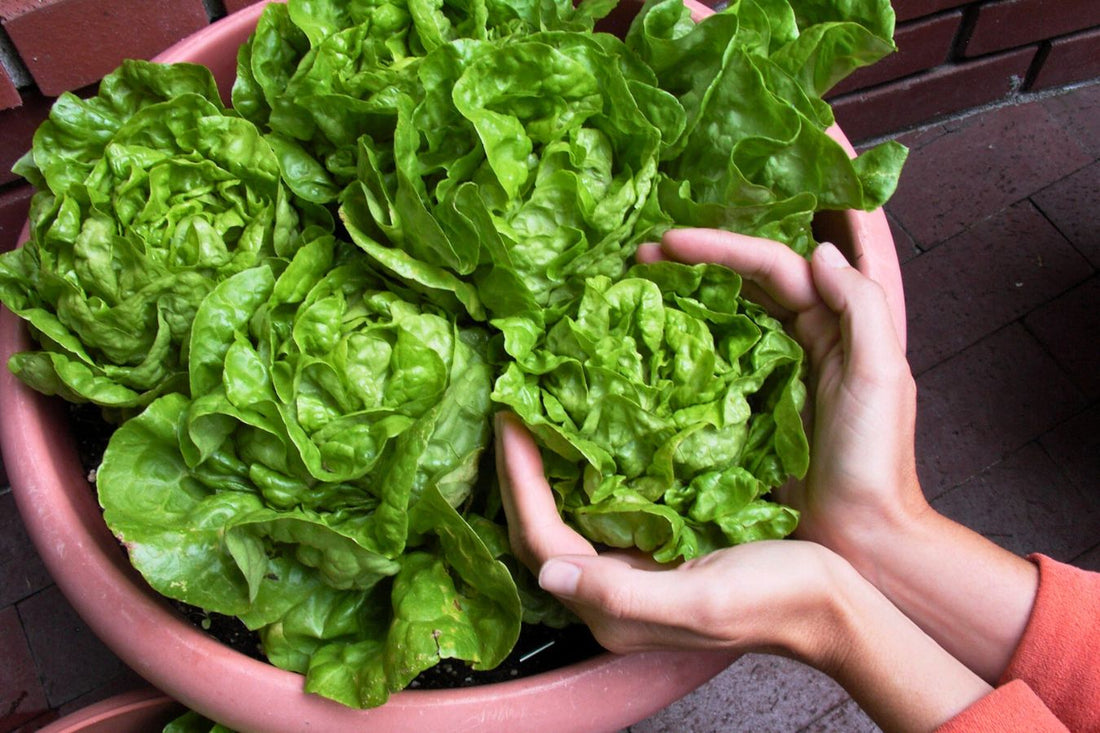
Growing heading lettuces, with their mosaic of colors, textures and leafy rosette shapes is one of the most rewarding aspects of having your own kitchen garden. Unfortunately, many of us have grown up identifying head lettuce only with the rock hard commercial iceberg and its pale water filled leaves. While there are, in fact, some quite nice home garden iceberg varieties, a large and very diverse world of other heading lettuces are available to grow from seed. They are well worth exploring for great flavor and beauty and offer the utility of extending the garden season in both directions.
"Heading" is a general and rather ambiguous term in describing lettuce forms, which can included everything from a tight, semi-solid heavy vase of crispy Romaine lettuce leaves, to softly folded, leafy rosettes of tender succulent butterhead leaves.
Leaf textures range from firm and crunchy to melting and buttery on the tongue, and colors are available from pale lime green to deep burgundy bronze and cool weather in spring or fall will bring out red hues to advantage. Within this wide array of choices there are three fairly distinct categories of heading lettuces to consider in planning your salad beds.
Commercial Romaines are being bred for large size and weight (the current nationwide popularity of Caesar salads featuring romaine has put a new premium on large scale production) and supermarket varieties can often have tough, rather leathery huge leaves. In your own garden, you can plant more tasty varieties of these sturdy heading lettuces. You'll find our fine heirloom Romaine included in the Caesar Duo for an excellent variety of texture and shape and flavor.
Batavians: The second general category of heading lettuces are the Batavians. Long popular as fresh market lettuces in Western Europe, especially in France, this beautiful and luscious class of lettuces is not yet grown for commercial distribution here in the U.S. Fortunately, kitchen gardeners can sample the very best Batavian varieties by buying seed. Batavians combine the sweet crispness of Romaine with a more open butterhead like shape. Many Batavians are remarkably resistant to hot weather bolting and their crispy leaves can be harvested from baby to full size plants. Color and leaf shape differ depending on variety, but all Batavians start out in an open broad leafed cluster and mature into a compact dense rosette of colorful substantial leaves. Use them in salads and sandwiches and as a flavorful crispy lettuce to shred for Mexican tostadas and taco salads or for combining with grapefruit sections, berries, sweet onions, ripe avocados or all kinds of cooked.
Growing Your Heading Lettuce: While it is certainly possible to grow good lettuce from seed sown directly into the garden, I get my best results starting seed in flats or containers. This way, I can keep the seeds evenly moist while they are germinating. Once they are up and growing, I can tend them carefully, protected from weather swings and pesky birds and insects while they are tiny and vulnerable. Use containers at least 2 inches deep filled with a good soilless seed starting mix. Sprinkle seeds thinly, about 1/4 to 1/2 inch apart, cover lettuce seed lightly and keep evenly moist. Germination is best at cool temperatures of 60˚ to 70˚F. After emergence in a week to 10 days, keep seedlings evenly moist. After several weeks, when they are several inches tall, transplant into the garden in finely prepared soil 4 to 6 inches apart. Do a final thinning to 12 inches apart when plants are 4 to 5 inches tall and enjoy the young succulent seedlings as your first rewards. This final thinning is important, as heading lettuces need proper spacing to grow to big beautiful heads. Do plan to do a late summer planting because fall grown lettuce stands beautifully without threatening to bolt or get bitter once the weather has cooled down.
Whenever you plant it, be certain to keep lettuce evenly moist to encourage even growth and sweet flavored leaves. Fertilize several times during the growing season with a dilute (1/2 strength) solution of fish emulsion and liquid kelp/seaweed to encourage leafy growth. Keep pesky birds from eating young lettuces by covering them with row cover or stringing reflective foil tape above the lettuce bed. If you see evidence of their damage, hand picking earwigs, slugs and snails rigorously after dark for 4 or 5 days when they are active is usually an effective way to deal with these pests. Otherwise, bait around the edges of the bed. If a spell of hot weather hits, or you must plant in hotter than desirable conditions, suspend shade cloth above the lettuce bed to protect the plants (available from garden centers) I've even used a big sun umbrella in an unexpected heat wave last spring. Keep the bed carefully watered. If weather continues very hot, plan on harvesting early when summer has really come on. When days begin to bake to 90˚F. range, finish eating your spring lettuce crop and wait until late summer to begin planting again.
While most kinds of seeds can be stored for several seasons lettuce seed is not a reliable keeper because it does not always hold its germination rate. If you do wish to keep extra seed, store it inside in a cool, dry place and plan to sow seed a little thicker the second season. Discard if you do not use after 2 seasons.
